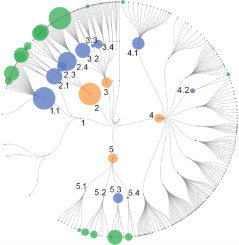当前位置:
X-MOL 学术
›
J. Proteomics
›
论文详情
Our official English website, www.x-mol.net, welcomes your feedback! (Note: you will need to create a separate account there.)
The developmental phosphoproteome of Haemonchus contortus.
Journal of Proteomics ( IF 3.3 ) Pub Date : 2019-12-14 , DOI: 10.1016/j.jprot.2019.103615 Tao Wang 1 , Guangxu Ma 1 , Ching-Seng Ang 2 , Pasi K Korhonen 1 , Andreas J Stroehlein 1 , Neil D Young 1 , Andreas Hofmann 1 , Bill C H Chang 1 , Nicholas A Williamson 2 , Robin B Gasser 1
Journal of Proteomics ( IF 3.3 ) Pub Date : 2019-12-14 , DOI: 10.1016/j.jprot.2019.103615 Tao Wang 1 , Guangxu Ma 1 , Ching-Seng Ang 2 , Pasi K Korhonen 1 , Andreas J Stroehlein 1 , Neil D Young 1 , Andreas Hofmann 1 , Bill C H Chang 1 , Nicholas A Williamson 2 , Robin B Gasser 1
Affiliation

|
Protein phosphorylation plays essential roles in many cellular processes. Despite recent progress in the genomics, transcriptomics and proteomics of socioeconomically important parasitic nematodes, there is scant phosphoproteomic data to underpin molecular biological discovery. Here, using the phosphopeptide enrichment-based LC-MS/MS and data-independent acquisition (DIA) quantitation, we characterised the first developmental phosphoproteome of the parasitic nematode Haemonchus contortus - one of the most pathogenic parasites of ruminant livestock. Totally, 1804 phosphorylated proteins with 4406 phosphorylation sites ('phosphosites') from different developmental stages/sexes were identified. Bioinformatic analyses of quantified 'phosphosites' exhibited distinctive stage- and sex-specific patterns during development, and identified a subset of phosphoproteins proposed to play crucial roles in processes such as spindle positioning, signal transduction and kinase activity. A sequence-based comparison of the phosphoproteome of H. contortus with those of two free-living nematode species (Caenorhabditis elegans and Pristionchus pacificus) suggested a limited number of common protein phosphorylation events among these species. Our findings infer active roles for protein phosphorylation in the adaptation of a parasitic nematode to a constantly changing external environment. The phosphoproteomic data set for H. contortus provides a basis to better understand phosphorylation and associated biological processes (e.g., regulation of signal transduction), and might enable the discovery of novel anthelmintic targets. SIGNIFICANCE: Here, we report the first phosphoproteome for a socioeconomically parasitic nematode (Haemonchus contortus). This phosphoproteome exhibits distinctive patterns during development, suggesting active roles of post-translational modification in the parasite's adaptation to changing environments within and outside of the host animal. This work sheds a light on the developmental phosphorylation in a parasitic nematode, and could enable the discovery of novel interventions against major pathogens.
中文翻译:

捻转血矛线虫(Haemonchus contortus)的发育磷酸化蛋白质组。
蛋白质磷酸化在许多细胞过程中起着至关重要的作用。尽管在社会经济上重要的寄生线虫的基因组学,转录组学和蛋白质组学方面取得了最新进展,但磷酸化蛋白质组学数据却不足以支撑分子生物学发现。在这里,使用基于磷酸肽富集的LC-MS / MS和数据独立获取(DIA)定量,我们表征了寄生线虫Haemonchus contortus的第一个发育磷酸化蛋白质组-反刍动物中最具致病性的寄生虫之一。总共,鉴定了来自不同发育阶段/性别的具有4406个磷酸化位点(“亚磷酸酯”)的1804个磷酸化蛋白。量化的“亚磷酸酯”的生物信息学分析在发育过程中表现出不同的阶段和性别特异性模式,并鉴定出一部分磷蛋白被提议在诸如纺锤体定位,信号转导和激酶活性等过程中发挥关键作用。基于序列的比较,H。contortus的磷酸化蛋白质组与两种自由生活的线虫(Caenorhabditis elegans和Pristionchus pacificus)的蛋白质组,发现这些物种中有限的常见蛋白质磷酸化事件。我们的发现推断出蛋白质磷酸化在寄生线虫适应不断变化的外部环境中的积极作用。捻转血矛线虫的磷酸蛋白质组学数据集为更好地了解磷酸化和相关的生物学过程(例如信号转导的调控)提供了基础,并且可能使发现新的驱虫靶标成为可能。意义:在这里,我们报道了社会经济上寄生的线虫(Haemonchus contortus)的第一个磷酸化蛋白质组。该磷酸化蛋白质组在发育过程中表现出独特的模式,表明翻译后修饰在寄生虫适应宿主动物内外变化的环境中的积极作用。这项工作揭示了寄生线虫中的发育磷酸化,并可能使发现针对主要病原体的新的干预措施。
更新日期:2019-12-17
中文翻译:

捻转血矛线虫(Haemonchus contortus)的发育磷酸化蛋白质组。
蛋白质磷酸化在许多细胞过程中起着至关重要的作用。尽管在社会经济上重要的寄生线虫的基因组学,转录组学和蛋白质组学方面取得了最新进展,但磷酸化蛋白质组学数据却不足以支撑分子生物学发现。在这里,使用基于磷酸肽富集的LC-MS / MS和数据独立获取(DIA)定量,我们表征了寄生线虫Haemonchus contortus的第一个发育磷酸化蛋白质组-反刍动物中最具致病性的寄生虫之一。总共,鉴定了来自不同发育阶段/性别的具有4406个磷酸化位点(“亚磷酸酯”)的1804个磷酸化蛋白。量化的“亚磷酸酯”的生物信息学分析在发育过程中表现出不同的阶段和性别特异性模式,并鉴定出一部分磷蛋白被提议在诸如纺锤体定位,信号转导和激酶活性等过程中发挥关键作用。基于序列的比较,H。contortus的磷酸化蛋白质组与两种自由生活的线虫(Caenorhabditis elegans和Pristionchus pacificus)的蛋白质组,发现这些物种中有限的常见蛋白质磷酸化事件。我们的发现推断出蛋白质磷酸化在寄生线虫适应不断变化的外部环境中的积极作用。捻转血矛线虫的磷酸蛋白质组学数据集为更好地了解磷酸化和相关的生物学过程(例如信号转导的调控)提供了基础,并且可能使发现新的驱虫靶标成为可能。意义:在这里,我们报道了社会经济上寄生的线虫(Haemonchus contortus)的第一个磷酸化蛋白质组。该磷酸化蛋白质组在发育过程中表现出独特的模式,表明翻译后修饰在寄生虫适应宿主动物内外变化的环境中的积极作用。这项工作揭示了寄生线虫中的发育磷酸化,并可能使发现针对主要病原体的新的干预措施。


























 京公网安备 11010802027423号
京公网安备 11010802027423号